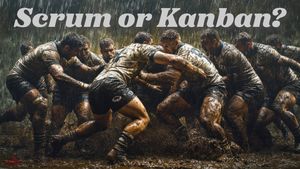Scrum or Kanban? Choosing the Right Path for Your Team
Very often I hear teams struggling with what agile method to choose—and perhaps even more so managers and stakeholders to the teams. So, is there a simple formula to help us decide which method to use? Scrum, Kanban, or maybe something entirely different?
In this article, I’ll explore the alternatives and give you the simple solution that any team can apply. So, let’s do it!

Scrum and Kanban Comparison
Let’s start by understanding the two methods and their core differences.
Kanban
The origins of Kanban can be traced back to the Toyota Production System in the 1940s, influenced by the work of Taiichi Ohno and W. Edwards Deming. The Kanban practices for knowledge work emerged later, starting with a team at Corbis in 2006, and have since evolved into a widely used approach.

At its core, Kanban is a workflow management method that optimizes the flow of value. The word “Kanban” itself means signboard or visual card, reflecting the method’s focus on visualizing work and managing workflows.
Key Kanban practices include:
- Visualizing work using Kanban boards.
- Limiting Work in Progress (WIP) to reduce bottlenecks and improve flow.
- Maximizing flow to ensure tasks move efficiently from start to finish.
The Kanban Board—with columns like To Do, In Progress, and Done—is central to the method. It allows teams to visualize their work, prioritize tasks, and identify blockers.
In essence, Kanban emphasizes continuous improvement and delivering value efficiently, one backlog item at a time.
Scrum
Scrum, as a framework, was formally introduced in the early 1990s, but its inspiration comes from the 1986 Harvard Business Review article “The New New Product Development Game” by Hirotaka Takeuchi and Ikujiro Nonaka.
The article emphasized a team-oriented, flexible approach to product development, drawing analogies to a rugby “scrum,” where the team advances together, similar to this articles main picture.
Scrum was later formalized by Jeff Sutherland and Ken Schwaber, and it became a cornerstone of Agile methodologies after the Agile Manifesto was published in 2001. The first Scrum Guide appeared in 2010.
Key Parts of Scrum
- Cross-functional teams: Teams bring together diverse skills to collaborate effectively.
- Sprint Cycles: Work is planned and delivered in time-boxed increments (1–4 weeks).
- Self-Organizing Teams: Teams are empowered to decide how to complete work.
- Continuous Learning: Through Sprint Reviews and Retrospectives, teams inspect and adapt.

From the Scrum Guide:
In a nutshell, Scrum requires a Scrum Master to foster an environment where:
- A Product Owner orders the work for a complex problem into a Product Backlog.
- The Scrum Team turns a selection of the work into an Increment of value during a Sprint.
- The Scrum Team and its stakeholders inspect the results and adjust for the next Sprint.
- Repeat.
Adaptations of Scrum
Scrum leaves room for teams to adapt practices to their context. Many Scrum teams borrow tools and techniques from other frameworks to enhance their process:
- Scrum Board: Borrowed from Kanban, a visual board increases transparency.
- User Stories: Introduced in Extreme Programming (XP), they express work from the user’s perspective.
- WIP Limits: Inspired by Kanban to improve focus and flow during a Sprint.
- Continuous Delivery: From Lean/DevOps principles, teams aim for frequent delivery.
While these adaptations are common, the key is ensuring they enhance Scrum without compromising its empirical foundation of transparency, inspection, and adaptation.
Similarities Between Scrum and Kanban
Despite their differences, Scrum and Kanban share key principles:
- Focus on Flow: Both aim to optimize work flow to deliver value efficiently.
- Visualization: Both use visual tools (like boards) to track progress.
- Work in Progress (WIP): Both emphasize limiting WIP to reduce bottlenecks and improve focus.
- Continuous Improvement: Both encourage inspecting, adapting, and improving processes.
- Transparency: Work must be visible and shared to enable collaboration.
Differences Between Kanban and Scrum
| Aspect | Scrum | Kanban |
|---|---|---|
| Time Management | Time-boxed Sprints (1–4 weeks). | Continuous flow, no time-boxing. |
| Roles | Defined roles: Product Owner, Scrum Master, and Developers. | No required roles; teams can self-manage. |
| Planning | Sprint Planning occurs at the start of each Sprint and as needed during backlog refinement. | Planning happens as needed, on a rolling basis. |
| Workflow Limits | WIP is implicitly limited through Sprint commitments. | Explicit WIP limits are set for each stage of work. |
| Delivery | Value is delivered at the end of a Sprint (yes, that is what the Scrum Guide says). | Delivery happens continuously as work completes. |
| Metrics | Velocity (completed stories per Sprint). | Cycle time, throughput, and work item age. |
What to Choose: Scrum, Kanban, or Both?
Many coaches simplify the choice: “If your work is plannable, use Scrum. If not, use Kanban.” But reality is rarely that simple.
What if we combine the strengths of both methods? Here’s what a blended approach could look like:
- Continuous Delivery: Use CI/CD pipelines to deliver value continuously.
- Kanban Board: Visualize workflow and set WIP limits within a Sprint.
- Smaller Batch Sizes: Break work into smaller increments for flexibility.
- Lanes for Classes of Service: Manage urgent and planned work with Kanban-style lanes.
- Capacity Allocation: Reserve capacity for different types of work (e.g., reactive vs. planned).
The result? The best of both worlds—Scrum’s structure and predictability combined with Kanban’s flexibility and flow.
1. "Isn't combining Scrum and Kanban just overcomplicating things?"
Objection: By blending the two frameworks, aren’t we creating unnecessary complexity that confuses teams and dilutes the benefits of both methods?
Response: A blended approach is not about forcing elements of both frameworks together. Instead, it’s about adopting the most valuable practices from each method to solve real challenges. The key is to adapt intentionally, keeping the team’s goals and context in focus. A good coach ensures simplicity remains intact while addressing inefficiencies.
2. "Won't continuous flow conflict with the structure of Scrum Sprints?"
Objection: Scrum thrives on time-boxed Sprints, while Kanban operates with a continuous flow. How do we reconcile this contradiction?
Response: Continuous flow doesn't have to replace time-boxing—it can enhance it. For example:
- Sprints can still provide structure and predictability for planning and reviews. Remember that Sprints are a planning period.
- Continuous delivery ensures work is released when ready, without waiting for the Sprint to end.
The two can coexist, enabling teams to balance predictability with agility.
3. "Why not just stick to Kanban if we need flow and WIP limits?"
Objection: If flow and WIP limits are so valuable, why not just use Kanban and abandon Scrum altogether?
Response: Scrum offers value beyond flow optimization, such as:
- Sprint Goals: Aligning teams around clear, time-bound outcomes.
- Cadence for Improvement: Scrum’s Retrospectives, Reviews, and Planning provide structured opportunities for reflection and collaboration.
By combining these strengths with Kanban’s flow practices, teams can achieve both alignment, efficiency, and predictability.
4. "How do we manage priorities across multiple Kanban lanes?"
Objection: Adding lanes for different classes of service might create confusion. How do we prioritize between lanes, especially when unplanned work competes with planned work?
Response: Capacity allocation solves this issue. By proactively reserving capacity for each lane—e.g., 20% for urgent work, 80% for planned work—teams strike a balance between responding to urgent needs and driving forward planned initiatives. Regular reviews ensure the balance remains appropriate as priorities shift.
5. "How do we measure success when combining frameworks?"
Objection: Scrum uses velocity, while Kanban focuses on cycle time and throughput. With a blended approach, how do we measure team performance?
Response: Teams should focus on outcomes, not outputs. Common metrics for combined approaches include:
- Cycle Time: How long does it take to deliver a work item?
- WIP Limits: Is work flowing efficiently without bottlenecks?
- Sprint Goals: Are teams achieving meaningful objectives within their cadence?
The combination allows teams to balance flow efficiency with achieving valuable outcomes.
6. "Does this hybrid approach still align with Agile principles?"
Objection: Combining methods might look like we’re “breaking the rules” of Scrum or Kanban. Are we still Agile?
Response: Agile is about responding to change and delivering value effectively, not following frameworks rigidly. By blending Scrum and Kanban, teams remain Agile as long as they:
- Deliver value continuously.
- Embrace collaboration and transparency.
- Adapt processes to fit their unique context and challenges.
The goal is outcome-driven agility, not compliance with any single method.
7. "We only work with trouble reports, so we can’t plan—shouldn’t we just use Kanban?"
Objection: Teams that primarily handle reactive work, such as customer trouble reports, may feel they don’t have plannable work and therefore shouldn’t use Scrum at all.
Response: All teams, even those focused on reactive work, have proactive opportunities to plan:
- Proactively scheduling improvement work to reduce future trouble reports.
- Allocating time for team development and technical debt reduction.
- Identifying recurring patterns to plan for potential issues in advance.
Balancing proactive and reactive work ensures teams continuously improve while addressing immediate needs.
But ... What About Scrumban?
While “Scrumban” is often used informally, Scrum.org’s Kanban Guide for Scrum Teams offers a structured approach to integrating Kanban practices into Scrum. This guide, published in 2021, helps teams combine flow optimization with Scrum’s cadence and roles.
Conclusion
Choosing between Scrum, Kanban, or a combined approach is not about following frameworks rigidly. It’s about solving real-world challenges effectively.
Scrum provides structure through Sprints, clear goals, and continuous improvement, while Kanban offers flexibility, optimized flow, and WIP limits. By intentionally blending practices, teams can balance planning, adaptability, and flow—achieving sustainable value delivery.
Ultimately, the “right” Agile methodology is the one that empowers your team to succeed.
References
- The Scrum Guide, 2020
- The Kanban Guide, 2020
- The Kanban Guide for Scrum Teams, 2021
Last updated May 27, 2025
